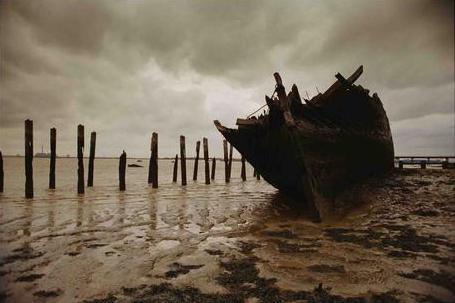
Photograph copyright ©1999 - 2018 Denis Waugh.
External Links
CLIFFE AND COOLING
In 851, when Alfred the Great was about three years old, 350 Viking ships sailed up the Thames to invade London. In 855 they set up camp on the Isle of Sheppey and in 865 the Kentish peninsular was overrun and the promise of Danegeld extracted from the men of Kent. Alfred never really got the hang of treating the Vikings as the hooligans they were rather than fellow Christians. He thought he had been proved right when his enemy Guthrum was baptised in 878, after the Battle of Edington, but he wasn't. After Alfred's death the raids continued as ever, which is why Edward the Elder (Alfred's son) paid 40 pounds of gold by way of ransom for a bishop in 914.
The delicate stone tracery aound the tower of Cooling Castle dates from 1381, at a time when raids from Europe were the threat. Just in 1380 a combined Spanish and French fleet had entered the Thames and burned and looted both Tilbury and Gravesend. Cooling Castle belonged to Sir John Oldcastle, Shakespeare's Falstaff. In the earliest version of Henry IV Falstaff is actually called Sir John Oldcastle, but the Cobham family objected; perhaps not surprisingly when you consider how far Shakespeare's greatest comic character strays from his original. Sir John Oldcastle (Lord Cobham thanks to his marriage) was certainly the one-time friend of King Henry V, but fell out of favour in 1413, shortly after his accession, by leading an ill-fated Lollard uprising. Rather than meeting the peaceful death Falstaff comes to after a life of drunken debauchery, Sir John was declared a heretic in 1414 and confined to the Tower, from which he escaped only to be captured near Welshpool and `hung and burnt hanging' for his religious zeal. Not much like Falstaff at all when you come to think of it.
In the churchyard of St James on Cooling Marshes are the
little stone lozenges, each about a foot and a half long, which were arranged in a neat row ... and were sacred to the memory of five little brothers of mine - who gave up trying to get a living exceedingly early in that universal struggle
and to which Pip was
indebted for a belief I religiously entertained that they had all been born on their backs with their hands in their trouser pockets, and had never taken them out in this state of existence.
This is the churchyard where Pip pondered on life and death and these marshes `intersected with dykes and mounds and gates, with scattered cattle feeding on it ... the low leaden line beyond [that] was the river...' were where our small, terrified hero from Great Expectations first encountered the escaped convict. This is pure Dickens country. But it is more than that.
If you head north from the church of St Mary at Higham and wander amongst the disused and flooded chalk quarries you may, with a little luck or an excellent map, come to Cliffe Fort, one of a ring of five built in the nineteenth century to frustrate Frankish ambitions. You may equally well, as I do, get lost and spend a good hour or so following lines of bullrushes, looking for the way across a network of drainage ditches and heaving your bike across ten-foot high gates. But pause a moment and reflect.
Have you ever before seen ships sailing apparently through marshlands with such ease? Have you ever seen a sky so vast, so evocative, so perfectly Dutch? This is pure Cuyp, pure Wouwerman. And when, finally, you mount the earthen seawall and find Cliffe Fort crumbling back to the earth, have you ever seen such perfection of colour and lack of colour? Have you ever seen such a silver as this, shafting the cloud to light the estuary? Have you ever seen such blacks as in this seaweed, as in these seeds of sea-hog fennel, as in those elderberries swooping through wine-red rosehips? And here in the mud is the blackening wreck of an old Finnish schooner which, en route from Sheerness in the 1960s, got this far and simply gave up the ghost; an atonement, perhaps, for the years of pillage? And see where those five jet-black cormorants stand in line, motionless, on the ruined jetty. They could almost be the shades of Mary's nuns, watching for Matilda's army.
Text copyright ©1999 - 2018 Priscilla Waugh.